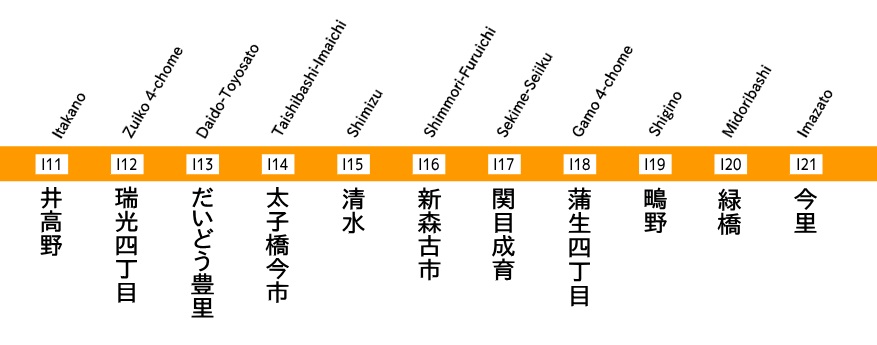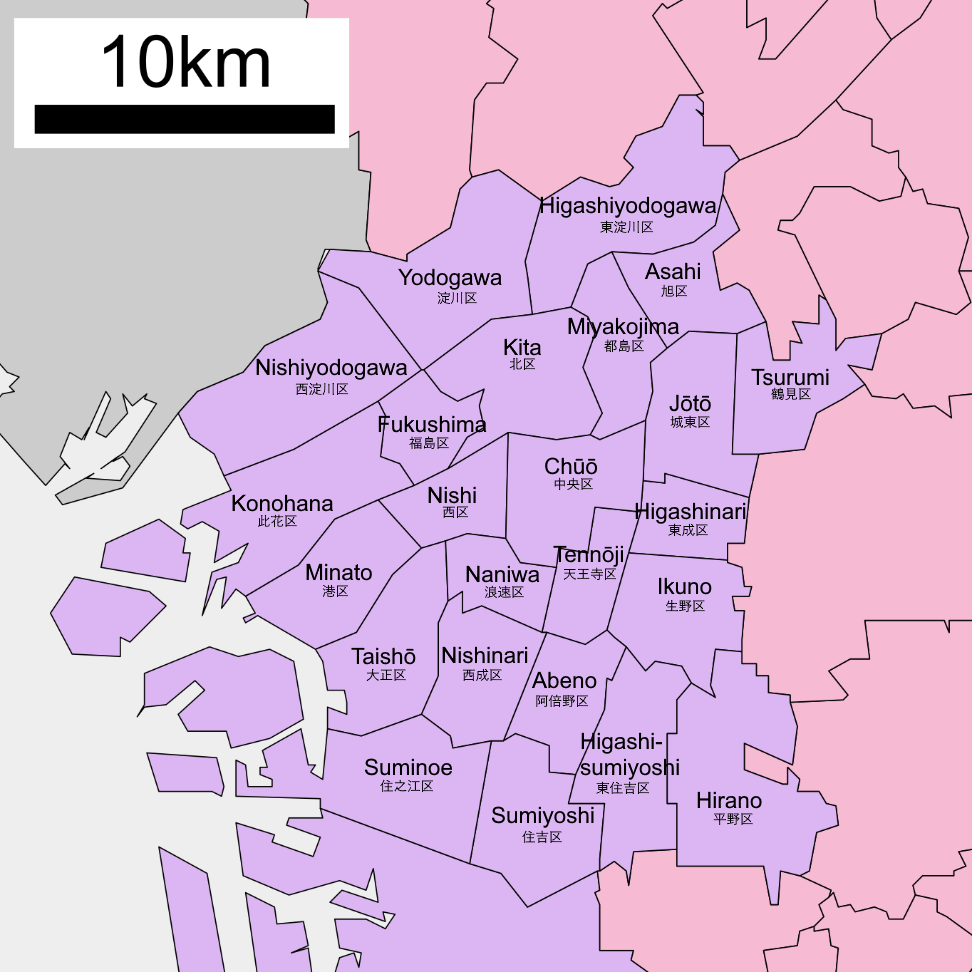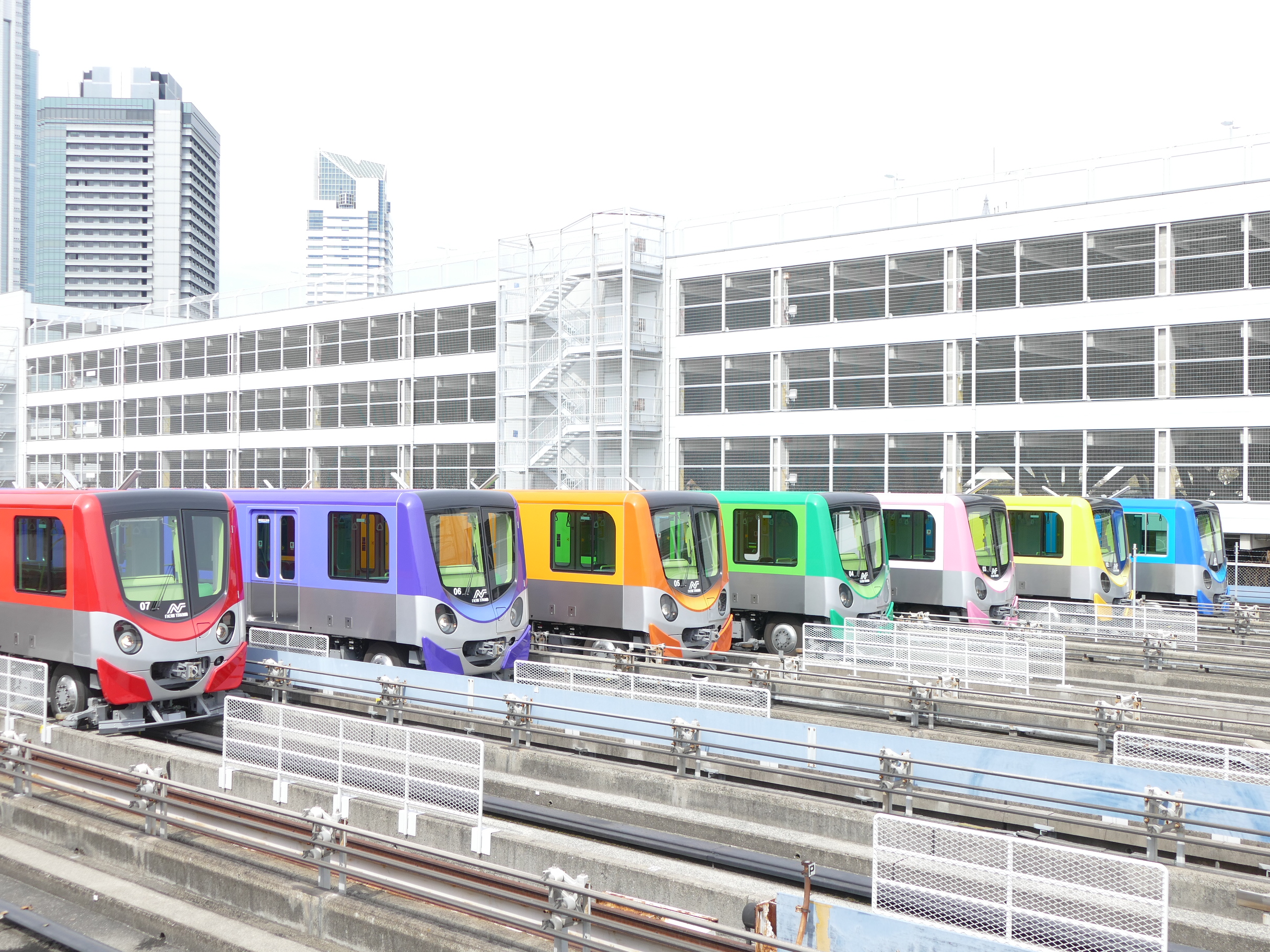|
Shimizu Station (Osaka)
is a train station on the Osaka Metro Imazatosuji Line in Asahi-ku, Osaka, Japan. It is the least used subway station in the Osaka Metro network, with only 5,439 people using the station daily in 2016. However, it is not the least used station in the entire network, as several stations of the Nankō Port Town Line have lower ridership figures. Layout The station has an island platform An island platform (also center platform, centre platform) is a station layout arrangement where a single platform is positioned between two tracks within a railway station, tram stop or transitway interchange. Island platforms are popular on ... fenced with platform gates between two tracks underground. Two siding tracks are located in the south of the station and connect to Tsurumi-ryokuchi-kita Depot and Tsurumi Inspection Depot. References Asahi-ku, Osaka Osaka Metro stations Railway stations in Japan opened in 2006 {{Osaka-railstation-stub ... [...More Info...] [...Related Items...] OR: [Wikipedia] [Google] [Baidu] |
Asahi-ku, Osaka
is one of 24 wards of Osaka, Japan. It is located in the northeast of the city, near the satellite town of Moriguchi. It was split off from Higashinari in 1932. Asahi-ku itself is further divided into the following areas (towns); Shimizu, Morishoji, Omiya, Nakamiya, Takadono, Akagawa, Ikue, Shinmori, Senbayashi, Taishibashi, and Imaichi. Asahi-ku borders the Osaka wards of: * Higashiyodogawa * Miyakojima * Joto * Tsurumi and the city of Moriguchi Transport Asahi-ku is served by the Tanimachi Line, and the Imazatosuji Line of the Osaka Metro and by the Keihan Main Line. Stations: *Tanimachi subway line: Sekime-Takadono Station, Sembayashi-Omiya Station, Taishibashi-Imaichi Station *Imazato Suji subway line: Shimmori-Furuichi Station, Shimizu Station, Taishibashi-Imaichi Station *Keihan Main Line: Morishoji Station, Sembayashi Station Schools There are 10 elementary schools (years one to six), four junior high schools (three years), two public and one private ... [...More Info...] [...Related Items...] OR: [Wikipedia] [Google] [Baidu] |
Osaka, Osaka
is a Cities designated by government ordinance of Japan, designated city in the Kansai region of Honshu in Japan. It is the capital of and most populous city in Osaka Prefecture, and the List of cities in Japan, third most populous city in Japan, following Special wards of Tokyo and Yokohama. With a population of 2.7 million in the 2020 census, it is also the largest component of the Keihanshin, Keihanshin Metropolitan Area, which is the List of metropolitan areas in Japan, second-largest metropolitan area in Japan and the 10th List of urban areas by population, largest urban area in the world with more than 19 million inhabitants. Osaka was traditionally considered Japan's economic hub. By the Kofun period (300–538) it had developed into an important regional port, and in the 7th and 8th centuries, it served briefly as the imperial capital. Osaka continued to flourish during the Edo period (1603–1867) and became known as a center of Japanese culture. Following the Meiji R ... [...More Info...] [...Related Items...] OR: [Wikipedia] [Google] [Baidu] |
Osaka Prefecture
is a Prefectures of Japan, prefecture of Japan located in the Kansai region of Honshu. Osaka Prefecture has a population of 8,778,035 () and has a geographic area of . Osaka Prefecture borders Hyōgo Prefecture to the northwest, Kyoto Prefecture to the north, Nara Prefecture to the southeast, and Wakayama Prefecture to the south. Osaka is the capital and largest city of Osaka Prefecture, and the List of cities in Japan, third-largest city in Japan, with other major cities including Sakai, Higashiōsaka, and Hirakata. Osaka Prefecture is the third-most-populous prefecture, but by geographic area the second-smallest; at it is the second-most densely populated, below only Tokyo. Osaka Prefecture is one of Japan's two "Fu (country subdivision), urban prefectures" using the designation ''fu'' (府) rather than the standard ''Prefectures of Japan#Types of prefecture, ken'' for prefectures, along with Kyoto Prefecture. Osaka Prefecture forms the center of the Keihanshin metropolitan ar ... [...More Info...] [...Related Items...] OR: [Wikipedia] [Google] [Baidu] |
Island Platform
An island platform (also center platform, centre platform) is a station layout arrangement where a single platform is positioned between two tracks within a railway station, tram stop or transitway interchange. Island platforms are popular on twin-track routes due to pragmatic and cost reasons. They are also useful within larger stations where local and express services for the same direction of travel can be provided from opposite sides of the same platform thereby simplifying transfers between the two tracks. An alternative arrangement is to position side platforms on either side of the tracks. The historical use of island platforms depends greatly upon the location. In the United Kingdom the use of island platforms is relatively common when the railway line is in a cutting or raised on an embankment, as this makes it easier to provide access to the platform without walking across the tracks. Advantages and tradeoffs Island platforms are necessary for any station with many th ... [...More Info...] [...Related Items...] OR: [Wikipedia] [Google] [Baidu] |
Train Station
A train station, railway station, railroad station or depot is a railway facility where trains stop to load or unload passengers, freight or both. It generally consists of at least one platform, one track and a station building providing such ancillary services as ticket sales, waiting rooms and baggage/freight service. If a station is on a single-track line, it often has a passing loop to facilitate traffic movements. Places at which passengers only occasionally board or leave a train, sometimes consisting of a short platform and a waiting shed but sometimes indicated by no more than a sign, are variously referred to as "stops", "flag stops", " halts", or "provisional stopping places". The stations themselves may be at ground level, underground or elevated. Connections may be available to intersecting rail lines or other transport modes such as buses, trams or other rapid transit systems. Terminology In British English, traditional terminology favours ''railway station' ... [...More Info...] [...Related Items...] OR: [Wikipedia] [Google] [Baidu] |
Osaka Metro
The is a major rapid transit system in the Osaka Metropolitan Area of Japan, operated by the Osaka Metro Company, Ltd. It serves the city of Osaka and the adjacent municipalities of Higashiosaka, Kadoma, Moriguchi, Sakai, Suita, and Yao. Osaka Metro forms an integral part of the extensive mass transit system of Greater Osaka (part of the Kansai region), having 123 out of the 1,108 rail stations (2007) in the Osaka-Kobe-Kyoto region. In 2010, the greater Osaka region had 13 million rail passengers daily (see Transport in Keihanshin) of which the Osaka Municipal Subway (as it was then known) accounted for 2.29 million. Osaka Metro is the only subway system in Japan to be legally classified as a tramway, whereas all other subway systems in Japan are legally classified as railways. Despite this, it has characteristics typical of a full-fledged metro system. Overview The network's first service, the Midōsuji Line from to , opened in 1933. As a north–south trunk route, it ... [...More Info...] [...Related Items...] OR: [Wikipedia] [Google] [Baidu] |
Imazatosuji Line
The is a rapid transit line of Osaka Metro, running from Itakano Station in Higashiyodogawa-ku to Imazato Station in Higashinari-ku, all within Osaka city. Its official name is , and in MLIT publications, it is written as . Station numbers are indicated by the letter I. The line first opened, at its present length, on Christmas Eve (24 December) 2006. The line color on maps, station signs, and train livery is . The line's symbol is a capital I on a solid golden-orange roundel; while all other lines use Parisine for their mark, the "I" of the Imazatosuji Line has serifs, similar to Verdana. Overview As with the Nagahori Tsurumi-ryokuchi Line, the Imazatosuji Line utilizes linear motor-driven trains with a cross-section 20% smaller than that of conventional subway cars, outfitted for driver-only operation. The line runs north–south through the eastern part of Osaka city, underneath National Route 479 (Osaka Inner Loop Route), National Route 163, National Route 1 (Keiha ... [...More Info...] [...Related Items...] OR: [Wikipedia] [Google] [Baidu] |
Osaka
is a designated city in the Kansai region of Honshu in Japan. It is the capital of and most populous city in Osaka Prefecture, and the third most populous city in Japan, following Special wards of Tokyo and Yokohama. With a population of 2.7 million in the 2020 census, it is also the largest component of the Keihanshin Metropolitan Area, which is the second-largest metropolitan area in Japan and the 10th largest urban area in the world with more than 19 million inhabitants. Osaka was traditionally considered Japan's economic hub. By the Kofun period (300–538) it had developed into an important regional port, and in the 7th and 8th centuries, it served briefly as the imperial capital. Osaka continued to flourish during the Edo period (1603–1867) and became known as a center of Japanese culture. Following the Meiji Restoration, Osaka greatly expanded in size and underwent rapid industrialization. In 1889, Osaka was officially established as a municipality. The construc ... [...More Info...] [...Related Items...] OR: [Wikipedia] [Google] [Baidu] |
Japan
Japan ( ja, 日本, or , and formally , ''Nihonkoku'') is an island country in East Asia. It is situated in the northwest Pacific Ocean, and is bordered on the west by the Sea of Japan, while extending from the Sea of Okhotsk in the north toward the East China Sea, Philippine Sea, and Taiwan in the south. Japan is a part of the Ring of Fire, and spans Japanese archipelago, an archipelago of List of islands of Japan, 6852 islands covering ; the five main islands are Hokkaido, Honshu (the "mainland"), Shikoku, Kyushu, and Okinawa Island, Okinawa. Tokyo is the Capital of Japan, nation's capital and largest city, followed by Yokohama, Osaka, Nagoya, Sapporo, Fukuoka, Kobe, and Kyoto. Japan is the List of countries and dependencies by population, eleventh most populous country in the world, as well as one of the List of countries and dependencies by population density, most densely populated and Urbanization by country, urbanized. About three-fourths of Geography of Japan, the c ... [...More Info...] [...Related Items...] OR: [Wikipedia] [Google] [Baidu] |
Osaka Municipal Transportation Bureau
Osaka Municipal Transportation Bureau (大阪市交通局, ''Ōsaka-shi Kōtsū-kyoku'') was the public department of transportation of the city of Osaka, Japan that existed from 1903 to 2018. It operated the municipal subway lines, the New Tram, and the city buses that have replaced the remaining lines of the municipal tram network. On April 1, 2018, the bureau was split into two private companies: Osaka Rapid Electric Tramway K.K. (known as Osaka Metro) and Osaka City Bus. Services provided *Municipal trams: 1903–1969 *City trolleybuses: 1953–1970 * Municipal subway: 1933–2018 (8 lines; Surutto KANSAI Cards and IC cards (PiTaPa and ICOCA The card is a rechargeable contactless smart card used on the JR West rail network in Japan. The card was launched on November 1, 2003 for usage on the Urban Network, which encompasses the major cities of Osaka, Kyoto and Kobe (Keihanshin). It ...) accepted) ** New Tram: 1981–2018 *City buses: 1927–2018 (103 regular bus routes, 29 ... [...More Info...] [...Related Items...] OR: [Wikipedia] [Google] [Baidu] |
Nankō Port Town Line
The , also called New Tram, is an automated guideway transit line in Suminoe-ku, Osaka, Japan. The line is operated by Osaka Metro, and was constructed to serve as the main public transportation for newly built Osaka South Port habitations and facilities. An extension of the line from Cosmosquare to Trade Center-mae was once owned and operated by an Osaka City's subsidiary, . The operation of the section was later merged to Osaka City transportation itself to increase the number of passengers by reducing fares previously calculated separately. Stations All stations are in Suminoe-ku, Osaka. Rolling stock , the following train types are used on the line, all formed as four-car sets. * 200 series four-car sets (since 29 June 2016) 200 series A fleet of four-car 200 series trainsets was introduced between 2016 and March 2017, all finished in different colour liveries. The first set, 01, entered revenue service on 29 June 2016, followed by the second set, 02, in October 2016. , ... [...More Info...] [...Related Items...] OR: [Wikipedia] [Google] [Baidu] |
Platform Screen Door
Platform screen doors (PSDs), also known as platform edge doors (PEDs), are used at some train, rapid transit and people mover stations to separate the Railway platform, platform from train tracks, as well as on some bus rapid transit, tram and light rail systems. Primarily used for passenger safety, they are a relatively new addition to many metro systems around the world, some having been retrofitted to established systems. They are widely used in newer Asian and European metro systems, and Latin America, Latin American bus rapid transit systems. History The idea for platform edge doors dates as early as 1908, when Charles S. Shute of Boston was granted a patent for "Safety fence and gate for railway-platforms". The invention consisted of "a fence for railway platform edges", composed of a series of pickets bolted to the platform edge, and vertically movable pickets that could retract into a platform edge when there was a train in the station. In 1917, Carl Albert West was ... [...More Info...] [...Related Items...] OR: [Wikipedia] [Google] [Baidu] |


.jpg)




